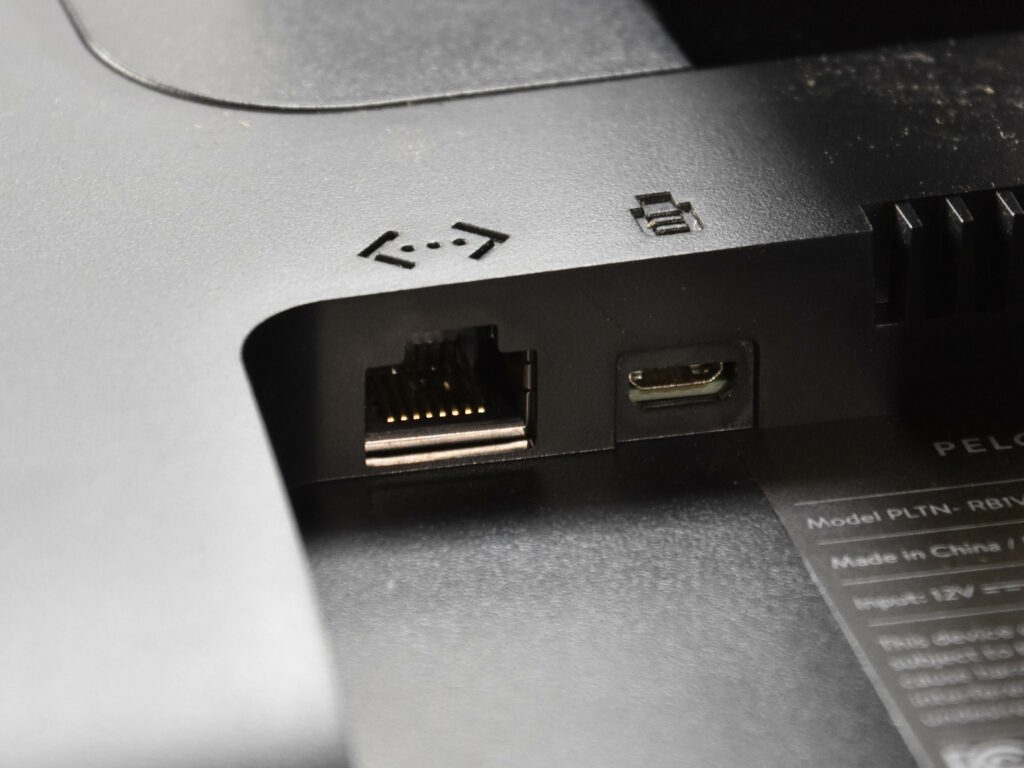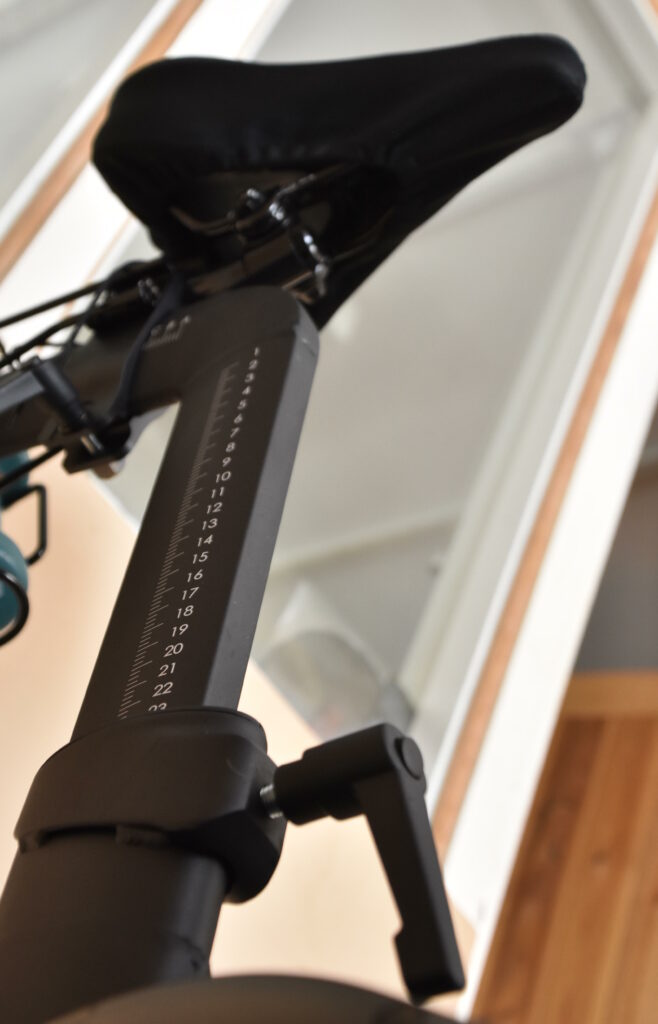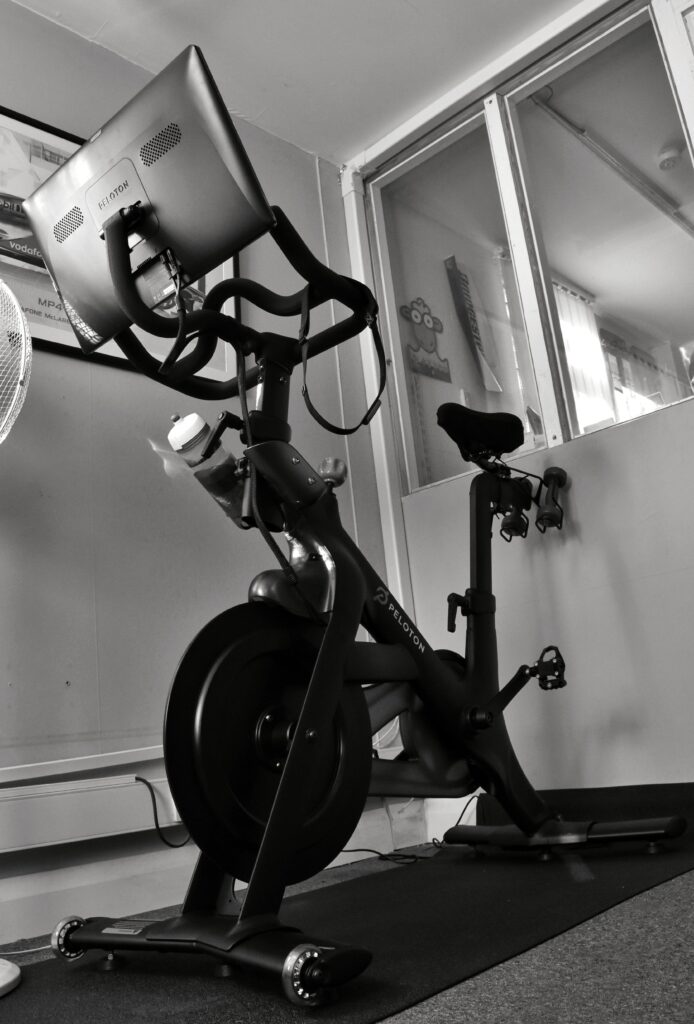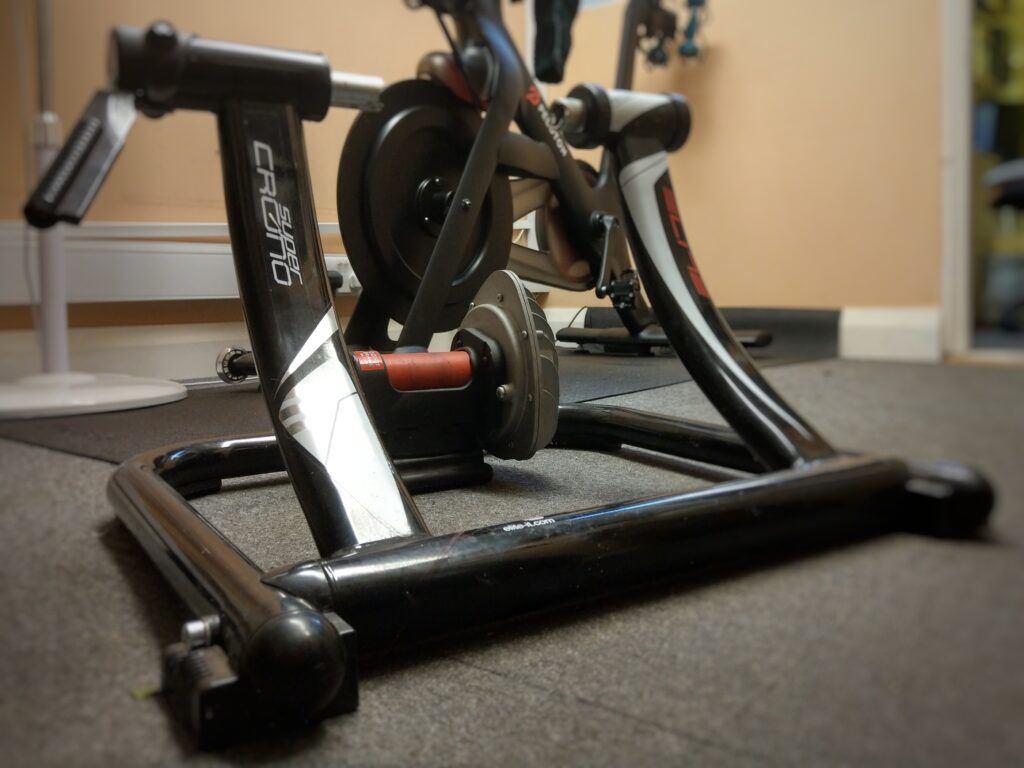October 2020 – Previously: Doing the Maths
I did something perhaps a bit surprising for a rural outdoorsy type last month: my partner and I ordered a Peloton.
Naturally Peloton make it very easy to sign up. There was a 3 week lead time for delivery, which was a little disappointing, but understandable in the current climate. One surprising thing is that we needed to activate the account directly from the bike, so we were on trial accounts until it arrived.
If you want to save a few quid, don’t buy the official Peloton heart monitor, shoes or other accessories. You can get perfectly adequate equipment cheaper elsewhere.

If you’re new to the whole scene, so called “clipless” pedals are very popular with cyclists. The pedals themselves have a kind of sprung clamp which locks onto a “cleat” on the shoe. So you need special cycling shoes that you can screw the cleats into.
With the shoes, make sure that you buy a pair that have the 3 bolts arranged in a triangle. Lots of shoes have this system or are compatible with this and more. You’ll need to get (Look) Delta cleats, not SPD or any other system. The cleats themselves should cost no more than £10.
For cyclists you’ll be pleased to hear that the pedals on the bike are standard, so if you want to swap them for SPDs or something, you can (although you might want to check the warranty conditions).
The same is true of the seat; it’s the standard dual rail clamp, so if you want to change it for your favourite Selle Italia bum wedge, you can.
Delivery
They call you about 1/2 hour ahead of delivery to sort out the fine detail. There’s a range of options, from dumping it at your door through to carrying to to the correct room and setting it up.
The bike comes pretty much assembled; if you’re even a basic Ikea warrior, you shouldn’t be afraid of assembling it yourself. Be aware of the adjustable feet, however. Mine took a bit of wrestling to move initially.
Do be aware that the bike is very heavy. Unless you’re Hafþór Björnsson I’d recommend getting the delivery people move it to the right level of your building. It does have wheels on the front, so once the bubble-wrap is removed it’s a lot easier to shuffle around.
If you are going to self-assemble, look out for the small black screws for the tablet (display); mine were taped to a reddish piece of packaging around the mount (on the bike). I nearly threw them away by accident. There’s also a Velcro strap that, depending on the height you set the handlebars, you may want to use to make absolutely sure that the monitor cable doesn’t rub on the flywheel.
The last physical thing to mention is to check that the existing nuts and bolts are tight. For me, one of the ones in the handlebars was loose.

The tablet is very obviously Android based. Booting it, connecting to WiFi, updating the software and activating the account were straightforward.
Obviously the device will be streaming video, and that takes quite a lot of WiFi bandwidth. On the standard bike there’s a wired Ethernet port, so if you have problems with the WiFi you can plug a cable between it and your router. Apparently this is not there on the Bike+, so you might want to consider this if you’re choosing between the two.
First Impressions
The height of the handlebars and both the height and the horizontal position of the saddle are easily adjustable, with handy guides so if there are more people using the bike settings can be easily remembered and adjusted.

The saddle angle is adjustable, but it’s a bit more tricky and not the kind of thing you would want to do for every ride. The saddle itself is perfectly OK for me, but I’m a male lifelong cyclist with buns of steel. Saddles are such a personal thing; I could easily understand some people wanting to replace it.
One of the advantages of SPD pedal system over Look Delta is that it’s much easier to make dual platform pedals, ones that can be used with out without cleats. Unfortunately you can’t do that with the Peloton pedals, you have to clip in, even for a quick, casual ride. I suspect this will annoy me, in time, and that I’ll change the pedals to dual platform SPDs.
Hopping aboard, the first and most obvious thing is that the mechanism is super-smooth and remarkably quiet. You can wind it up to over 500 Watts and it’s still barely more than a whisper.
As someone who’s used plenty of spin bikes in commercial gyms, the flywheel feels a little light. However, the resistance mechanism is very silky and that goes a long way to compensate.,
The tablet boots quickly, but it does get a bit cranky if, say, you attempt an artistic dismount, fail to unclip properly and, in the process of faceplanting into a nearby aspidistra, manage to tear the cable out of the wall socket. If you plan to turn it off at the mains when it’s not in use, you may want to turn it on a minute or two before you plan to use it.
Having backed the tension adjusters on the pedals off a few notches I could look more at the tablet. It works well, its layout is intuitive to any user of smart devices. There’s a live, very clear measurement of cadence (how fast you’re spinning the pedals), resistance and a calculation of output power. If you want, you can fire up the “Just Ride” option and work with it simply as a training bike.
Bluetooth audio is an option, the standard bike has an aux out (3.5mm jack) and you can even cast the video to an external screen. I was surprised how good the onboard audio is though, it’s quite good enough for the purpose. We will see, in a few months, if I still think that, however. My finger’s already twitching over the SuperFi web site.
There’s no need to cast the screen (for regular use), the onboard is plenty good enough. Of course, you could run non-spin classes cast from the bike itself, but wouldn’t you just use your phone/tablet for that?
My (Garmin) Heart monitor connects easily and works flawlessly. It doesn’t complain if I don’t hook a heart monitor up, which is good because the things annoy me. I only use one to get a baseline every so often.
So far I’m impressed. It’s definitely the best piece of home gym equipment I’ve ever owned – but there again it’s also the most expensive. Will it live up to the price-tag? I’ll let you know in the next update!
Be sure to check out the other articles in the series:
- The Peloton Diaries: Doing the Maths – the story of how I got on board this particular train.
- The Peloton Diaries: First Week – what it’s like climbing aboard and trying to get up to speed.
- The Peloton Diaries: We Ride as One – the Peloton philosophy and why that’s important.
- The Peloton Diaries: The Maths Club and #PELO4WINE – we are not the people you might expect.

